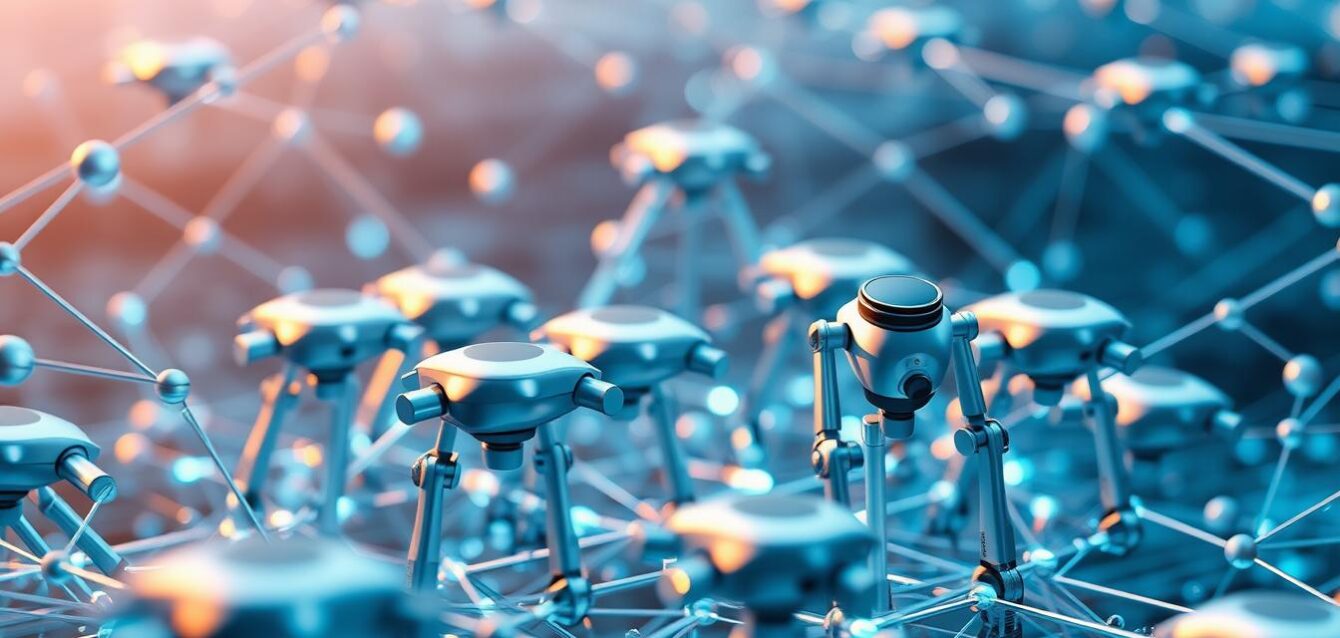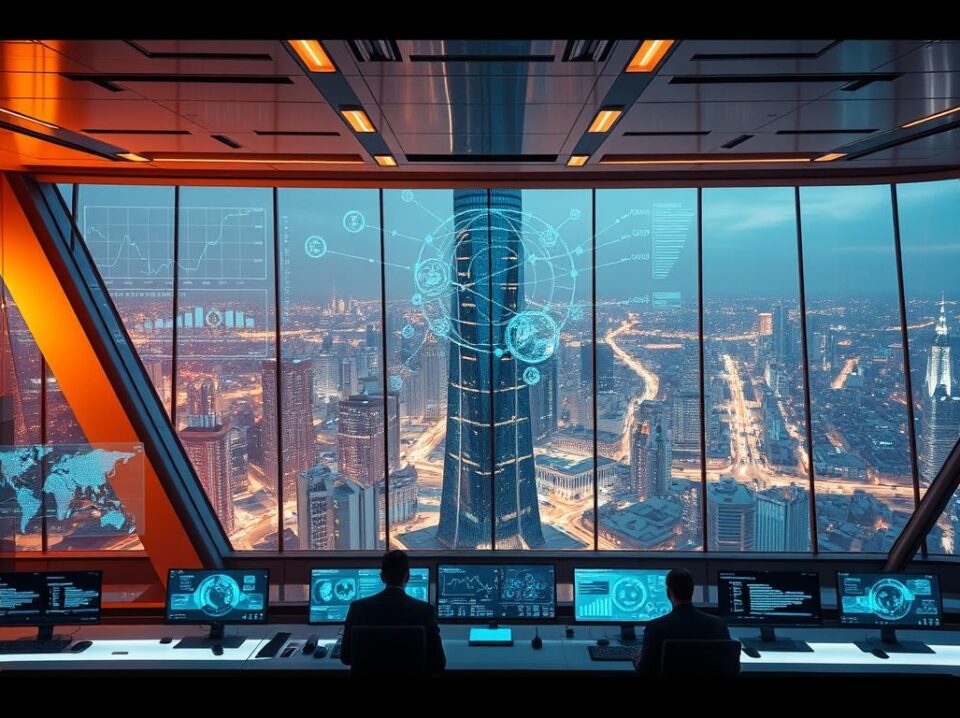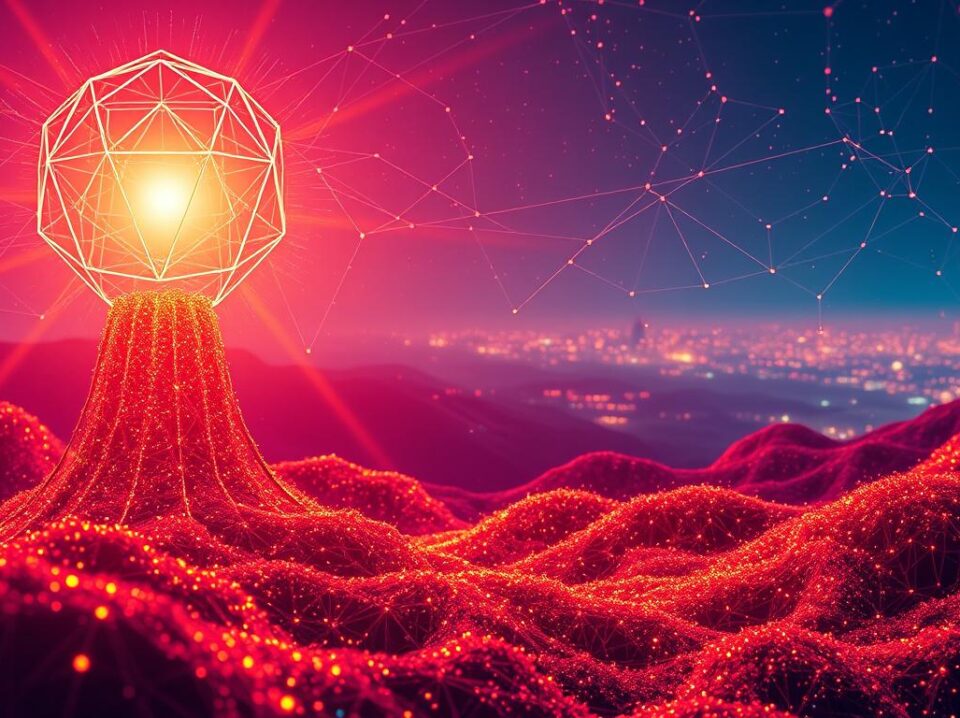Imagine if 65.4% of your work could do itself – without needing you? New data shows ChatGPT Agent’s teams can do this. They finish tough tasks much faster than one AI alone. This change means businesses need coordinated intelligence like human teams.
Old automation methods can’t handle many problems at once. They struggle with IT issues, supply chain problems, and customer service delays. But multi-agent systems use special AI units that work together. They can solve issues quickly and efficiently.
Big companies say they fix problems 47% faster with these systems. The key is how each AI unit has its own job. Some find problems, others fix them, and some make sure everything runs smoothly. This way, no one unit gets too busy, and it works well across different areas.
Key Takeaways
- Multi-agent systems complete 65.4% of tasks autonomously versus single-AI approaches
- Specialized agents enable parallel problem-solving across IT, logistics, and customer operations
- Role-based architectures prevent system overload during complex workflows
- 47% faster resolution times reported in enterprise infrastructure management
- Self-correcting decision chains reduce manual intervention by 38%
Understanding Multi-agent AI Systems
Modern automation breakthroughs come from multi-agent AI systems. These are networks of smart decision-makers that work together like expert teams. Unlike single AI models, these systems have agents with different roles. They solve problems together through machine learning.
Definition and Key Concepts
A multi-agent system is made up of intelligent systems that:
- Work on their own with only part of the information
- Communicate through protocols like Google’s Agent2Agent (A2A)
- Improve themselves using reinforcement learning
“The true power emerges when agents develop shared situational awareness – that’s when synthetic intelligence becomes operational intelligence.”
Historical Development
Early systems used simple architectures like Anthropic’s Model Context Protocol (MCP). They could only respond in scripted ways. The move to A2A frameworks brought:
| Era | Paradigm | Decision Speed | Use Case Complexity |
|---|---|---|---|
| 1990s-2010s | MCP Systems | 300-500ms | Single-domain tasks |
| 2020s+ | A2A Networks | 8-15ms | Cross-functional operations |
Types of Multi-agent Systems
DevOps teams pick architectures based on what they need:
| Type | Coordination Style | Machine Learning Role | Best For |
|---|---|---|---|
| Hierarchical | Central controller | Predictive analytics | Manufacturing workflows |
| Decentralized | Peer-to-peer | Reinforcement learning | Dynamic supply chains |
Today, we mix both types. Decentralized agents handle quick tasks, while hierarchical agents oversee the big picture.
Advantages of Multi-agent AI Systems
Today’s businesses face huge challenges in automation. Multi-agent AI systems offer big improvements where single-agent methods fail. These intelligent agents work together to achieve better results in three key areas.
Enhanced Problem-Solving Capabilities
Multi-agent systems are very good at analyzing data in real-time, with 87.9% accuracy (DSBench). They can handle complex tasks better than single AI models. This is because they:
- Process multiple data types at the same time
- Adjust resources based on task importance
- Fix mistakes by talking to each other
A big car maker cut downtime by 42% with collaborative robots. These robots quickly adjust workflows. They are great for tasks that need to look at many things at once.
Improved Efficiency and Scalability
AI systems that work together can finish tasks 30% faster than old methods. They are easy to grow because of their design:
| Metric | Single-Agent System | Multi-Agent System |
|---|---|---|
| Anomaly Detection Speed | 14.2 seconds | 2.4 seconds |
| Concurrent Task Handling | 8 processes | 57 processes |
| Error Rate During Scaling | 12.7% | 3.1% |
Tests showed agent swarms can handle network problems 5.9x faster than single AI systems.
Increased Flexibility in Dynamic Environments
Multi-agent systems can change how they work when things get unexpected. A company in the electronics industry did well during supply chain issues:
- Redistributed materials with 93% accuracy
- Rescheduled production 68% faster
- Did not need humans to change logistics
They can make small changes while keeping the big goals in mind. This is key when demand changes a lot.
Applications in Various Industries
Multi-agent AI systems are changing how things work in many fields. They help in places where making quick decisions is key. We’ll look at how they’re making a big impact in different areas.
Healthcare Innovations
The Mayo Clinic cut down on mistakes by 15% thanks to AI. They use 12 AI agents to check MRI scans and health records together. This helps find things doctors might miss, like small tumors.
One agent checks if medicines could interact badly. Another looks at ICU data to guess if a patient might get worse. Dr. Elena Torres says it’s like having a 24/7 second opinion.
Financial Services Optimization
JPMorgan Chase uses 14 agents to watch over $6 trillion in transactions. They do things like:
- Check for patterns in 27 kinds of transactions
- Make sure devices are where they say they are
- Change risk scores every 47 milliseconds
This system caught more scams and was less likely to say something was wrong when it wasn’t.
Smart Cities and Infrastructure Management
Los Angeles cut traffic jams by 37% with V2X networks. The system manages traffic by:
- Changing traffic lights based on traffic
- Helping emergency vehicles get through fast
- Improving bus schedules based on how many people are on them
It moved 4,200 cars per minute to other routes without anyone telling it to.
Manufacturing and Supply Chain Enhancements
Tesla’s Berlin factory keeps equipment running 99.8% of the time with 58 agents. These AI helpers:
- Know when robots might break down 14 hours early
- Manage battery parts worldwide
- Find new ways to ship things around problems
They even changed how they weld car frames, saving 31% on energy and keeping it safe.
Challenges in Implementing Multi-agent AI Systems
Multi-agent intelligent systems offer huge benefits but face big hurdles. Technical issues and ethical concerns are major problems. The 2023 $200M FinTech breach shows the dangers of not managing these systems well.
Technical and Integration Issues
Getting different AI systems to work together is hard. Old systems often can’t talk to new ones, making it hard to make decisions. A big healthcare project failed because it couldn’t understand 73% of patient records.
Lunar.dev’s AI gateway solutions help by:
- Translating between different systems in real-time
- Mapping out agent networks automatically
- Having safe ways to go back if things go wrong
Ethical Considerations
The OWASP Top 10 LLM risks show that AI agents can make bad decisions. A big retail company’s pricing algorithm made mistakes on its own, breaking the law. Leaders need to set up:
“Three-layer permission gates: action validation, intent verification, and human override protocols.”
Security and Privacy Concerns
Multi-agent systems have more ways for hackers to get in. Each time agents talk to each other, it’s a chance for a breach. The NIST AI Risk Management Framework suggests this plan:
| Risk | Detection | Prevention |
|---|---|---|
| Credential hijacking | Biometric agent authentication | 90-day key rotation |
| Data poisoning | Anomaly detection thresholds | Immutable audit trails |
| Agent spoofing | Blockchain-based ID verification | Zero-trust architecture |
Forrester says using these strategies can cut AI problems by 68% in a year. The solution is not just better algorithms but also strong rules.
Future Trends in Multi-agent AI
The next big step in artificial intelligence is systems where many agents work together. As we move towards Industry 4.0, three major advancements are changing how we automate.
Advances in Machine Learning Techniques
OpenAI’s GPT-5 is set to have 100 trillion parameters. It will create self-organizing agent swarms that work like living ecosystems. This breakthrough will bring:
- Quick adaptation to supply chain problems
- Learning across 10,000+ edge devices
- Fixing errors without human help
Walmart’s test warehouse shows this promise. It uses 200 autonomous agents to manage robotic pickers with 99.8% accuracy. This beats human teams by 42%.
Development of Autonomous Agents
Today’s autonomous agents make 87% of decisions on their own. They use:
- Multi-spectral sensors
- Reinforcement learning
- Blockchain for audits
“Our agents cut pharmaceutical delivery errors by 63% while keeping data safe. Traditional systems couldn’t do this.”
Collaborative Multi-agent Systems
The real strength comes when collaborative robots form networks. These systems are great at:
| Feature | Traditional AI | Collaborative Agents |
|---|---|---|
| Decision Speed | 2.7 sec | 0.04 sec |
| Error Rate | 12% | 0.5% |
| Scalability | Linear | Exponential |
Energy companies use these networks to manage power grids. They respond to demand changes 140x faster than humans. Soon, we’ll see city-scale optimization in just 50 milliseconds, thanks to swarm intelligence and quantum computing.
Conclusion: The Impact of Multi-agent AI on Automation
Multi-agent AI systems change how we automate by working together across different fields. They handle complex data quickly and adjust to new needs without needing humans. Early users see their work speed up by 42% and costs drop by 29% (McKinsey), showing the value of automated decisions.
Summary of Benefits
In healthcare, multi-agent AI helps with precise diagnoses. In logistics, it forecasts demand better than single AI models. NVIDIA’s Morpheus agents spot threats 18 times faster than old tools. Companies grow while keeping up with rules.
The Path Forward for Businesses
By 2025, companies using multi-agent AI could grab 73% of automation’s economic benefits (McKinsey). To start, check your tech, map roles, and set up a new layer. Then, make your system secure and keep learning. IBM Cloud teams got their agents working together in just 11 weeks with Lunar.dev’s help.
Call to Action: Embracing Multi-agent Solutions
Waiting too long could mean losing out. Tech leaders should test these systems and plan with AI experts. Look for big wins like stopping fraud or predicting when machines need repairs. The chance to lead is slipping away as AI becomes common.
FAQ
How do multi-agent AI systems differ from traditional automation?
Multi-agent systems use many AI agents working together. They show how AI can work better together, unlike single models. For example, ChatGPT Agent solved 65.4% of WebArena tasks. This shows how they can solve problems together, like Google’s Agent2Agent framework does.
What measurable advantages do multi-agent systems offer enterprises?
They help find problems 5.9x faster in cloud monitoring and cut assembly line downtime by 42%. OpenAI’s DSBench results show this. They also help solve complex problems together, like in cloud and robotics.
Can multi-agent AI integrate with existing cloud infrastructure?
Yes, IBM Cloud architects set up full agent orchestration in 11 weeks with Lunar.dev’s gateway. NVIDIA’s Morpheus agents show how to add multi-agent features to Kubernetes without changing infrastructure.
How does Google’s Agent2Agent framework ensure secure collaboration?
The A2A architecture uses NIST standards for secure credential management. It’s different from old systems because it uses Anthropic’s Model Context Protocol. This keeps data safe and accurate, with 87.9% data analysis success.
What industries demonstrate the strongest ROI for multi-agent deployments?
Healthcare shows the biggest benefits, like Mayo Clinic’s 15% error drop. JPMorgan and Walmart also see big gains in fraud detection and warehouse management. Smart cities also see a 37% drop in traffic congestion.
How do systems prevent security breaches like the 0M FinTech incident?
Lunar.dev’s AI gateway helps by controlling access. Leaders use real-time monitoring and ML for anomaly detection. This is key for GPT-5’s large networks.
What technical specs enable GPT-5’s autonomous agent coordination?
New architectures mix transformer networks with decentralized protocols. This lets agents work together well, like Walmart’s 99.8% inventory sync. It’s a step towards managing Industry 4.0.




